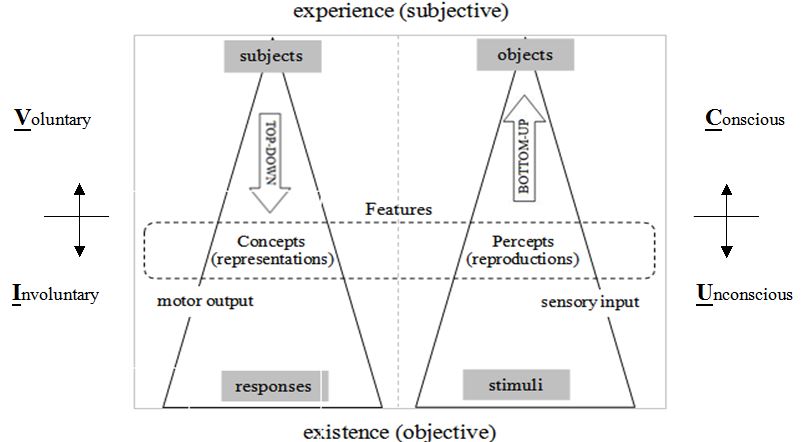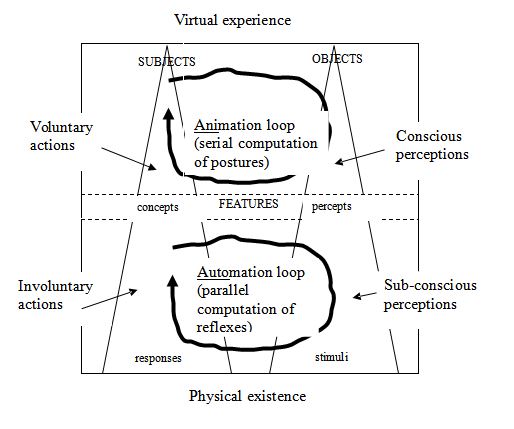Cybercognition - Cybernetic Computational Cognition Theory -© 2014
.
.
The Cybernetic-Computational Engine - an intelligent agent with internal experience
by Charles Dyer BE (Mech.) BSc (Hons). Copyright © October 2014
Cybernetic-Computational Paradigm
by Charles Dyer BE (Mech.) BSc (Hons). Copyright © October 2014
Cybernetic-Computational Paradigm
The CCE is the first truly intelligent and conscious computer design. Its author/inventor is Charles Dyer, from Flinders University[1], in South Australia. Discovering[1] the CCE was the next research stage after the discovery of the TDE. While the TDE is an applied cognition model intended for medical and scientific investigations (eg into the stages of cognitive evolution), the CCE project was created in order to answer much more basic questions about the possible ways to design intelligent machinery. The CCE itself is the end product of several years of complicated proto-mathematical analysis. The CCE is the only possible generic template for an intelligent machine. Hence we can introduce the term 'orthomata'. This concept resembles that of Descartes, who regarded this feature of all minds, especially human, as a 'god' principle. All intelligent machines (conscious, motivated knowledge gathering and using agents) are implementations of the CCE pattern. All fully featured human languages are 'blueprints' of CCE machines. Language and cognition are clearly demonstrated by CCE theory to be behaviours produced by the same shared substrate, namely the CCE design.
extent (contiguous region between place limits/ limiting lengths)
episode (contiguous region between event limits/ limiting times
space (collection of separable places)
epoch (collection of separable events)
location (locus -goal - indexed context )
position (focus - target - indexed content)
process (linked/finite cycle of states)
Mechanism (structurally constrained process)
Machine
Memory
Map (read-only memory)
Implementation (decoding)
Representation (encoding)
channel (location of stimuli)
Information (collection of event values- process)
Data (collection of event detectors)
1. This is the same geographically obscure institution which fostered the amazing and successful minds of both Rodney Brooks (world class roboticist) and David Chalmers (world class philosopher of mind).
2. Do scientists discover new facts or invent new theories? It depends on whether they are doing deductive science (from theory to prediction) or inductive science (from data to theory). Some scientists (for example, Albert Einstein) never do any original experimentation at all, but use the data of other researchers, limiting their focus to theoretical development (invention and testing of new, better hypotheses). Theoretical scientists try to explain stuff that doesn't fit current theories.
2. Do scientists discover new facts or invent new theories? It depends on whether they are doing deductive science (from theory to prediction) or inductive science (from data to theory). Some scientists (for example, Albert Einstein) never do any original experimentation at all, but use the data of other researchers, limiting their focus to theoretical development (invention and testing of new, better hypotheses). Theoretical scientists try to explain stuff that doesn't fit current theories.

Knowledge
Behaviour
Actor
Agent
Object (inter-subject / public viewpoint)
Subject (intra-subject / private viewpoint)
layer (contents / members of collection)
level (context / membership of collection)
feature (perceptual entity
Physical (subject's existential level - public I/O - concrete features)
Virtual (subjects experiential level - private I/O - abstract features)
Collection (group of features)
Percept (inter-subject / public collection)
Concept (intra-subject / private collection)
Hierarchy (meta-collection)
system (named organisation)
purpose (named operation)
Behaviour
Actor
Agent
Object (inter-subject / public viewpoint)
Subject (intra-subject / private viewpoint)
layer (contents / members of collection)
level (context / membership of collection)
feature (perceptual entity
Physical (subject's existential level - public I/O - concrete features)
Virtual (subjects experiential level - private I/O - abstract features)
Collection (group of features)
Percept (inter-subject / public collection)
Concept (intra-subject / private collection)
Hierarchy (meta-collection)
system (named organisation)
purpose (named operation)
CCE Definitions
This page is organised in an unusual way. The definitions needed to create an unambiguous theory are presented first. The purpose of this is to prevent the reader from forgetting the precise, definition-led nature of all similar theory building exercises. Note the use of the descriptors 'organisation' and 'operation' to describe architectural navigation and regulation. These concepts resemble Piaget's two aspects of Adaptation (=Assimilation + Accomodation).
1. We begin by reciting Kant's subjectivity principle- all that we know is sensory, ie perceptually constructed. All closed-loop events, or effects are sensory. William James, the so-called 'father of psychology' called this the principle of 'common-coding. What he meant was, in order to create difference engines (action loops) all information flows must either be expressed as perceptual values, or as production (conceptual) units.
2. All open-loop events are causal, and all causes are open-loop (motor) events. They are starting points, like function invocations. They define what is called 'agency' - the power to change states of self-in-world.
3. Conscious (cybernetic, feedback guided) machines use perceptual common coding- stimuli, and their aggregate (postural) forms
4. Subconscious (computational, feedforward guided) machines use conceptual common coding- responses, and their aggregate (reflexive) forms.
1. We begin by reciting Kant's subjectivity principle- all that we know is sensory, ie perceptually constructed. All closed-loop events, or effects are sensory. William James, the so-called 'father of psychology' called this the principle of 'common-coding. What he meant was, in order to create difference engines (action loops) all information flows must either be expressed as perceptual values, or as production (conceptual) units.
2. All open-loop events are causal, and all causes are open-loop (motor) events. They are starting points, like function invocations. They define what is called 'agency' - the power to change states of self-in-world.
3. Conscious (cybernetic, feedback guided) machines use perceptual common coding- stimuli, and their aggregate (postural) forms
4. Subconscious (computational, feedforward guided) machines use conceptual common coding- responses, and their aggregate (reflexive) forms.
In the CCE analysis, however, the sensor and motor hierarchies are drawn separately, side-by-side, so that the similarities and differences in their functionality can be compared. The most important point to note is that in the top-down (Marr-Poggio) motor hierarchy, the tree-branch-creation process, ie the collection of subordinate elements (children) into a superordinate group (parent), IS A REPRESENTATION, IE CREATED BY THE PRIMARY AGENT, SELF OR SUBJECT, while in the bottom-up (Tinbergen-Chomsky) sensor hierarchy, the class-creation process IS A REPRODUCTION, IE CREATED BY SECONDARY AGENTS, OR OTHERS.
Typically, a subject will represent its own sense of self agency by a sub-hierarchy in the left hand hierarchy or pyramid, and its own body by a sub-hierarchy in the right-hand pyramid, which represents physical objects at the apical abstraction level. The subject learns about the outside world in a two-stage process-
1. semantics -supervised learning of dependency relationships by observation of a teacher (classical conditioning) - left pyramid
2. syntax - unsupervised learning of constituent relationships by mimicry of teacher (operant learning) - right pyramid
The key to the success of the model is the theoretical and functional separation of the comprehension and expression phases of language. The 'consumers problem' (given method or syntax, evaluate motive or semantics) and the 'producers problem' (known motive or semantics, invent method or syntax) are analysed as separate issues in language. The two aspects of linguistics have always been regarded as somewhat distinct. That is, generative linguistics (meaning production) has always been treated separately from comparative linguistics (language understanding).
Typically, a subject will represent its own sense of self agency by a sub-hierarchy in the left hand hierarchy or pyramid, and its own body by a sub-hierarchy in the right-hand pyramid, which represents physical objects at the apical abstraction level. The subject learns about the outside world in a two-stage process-
1. semantics -supervised learning of dependency relationships by observation of a teacher (classical conditioning) - left pyramid
2. syntax - unsupervised learning of constituent relationships by mimicry of teacher (operant learning) - right pyramid
The key to the success of the model is the theoretical and functional separation of the comprehension and expression phases of language. The 'consumers problem' (given method or syntax, evaluate motive or semantics) and the 'producers problem' (known motive or semantics, invent method or syntax) are analysed as separate issues in language. The two aspects of linguistics have always been regarded as somewhat distinct. That is, generative linguistics (meaning production) has always been treated separately from comparative linguistics (language understanding).

The Existence-Experience diagram depicts the two high-level computational sub-types- serial animation of postures over parallel automation of reflexes (see Schneider & Schiffrin 1977).
Organisation (collection of system goals - roles and gates - the office or job)
Operation (collection of system targets - rotes and rates - the work or task)
Operation (collection of system targets - rotes and rates - the work or task)